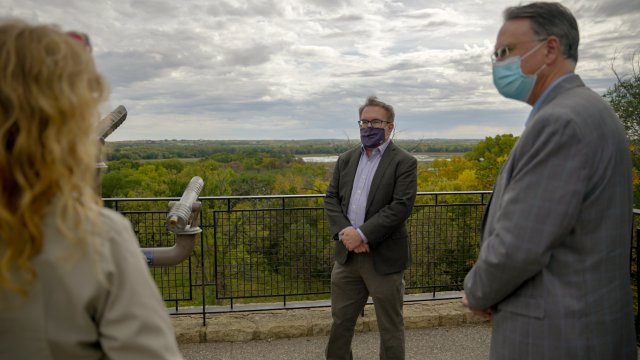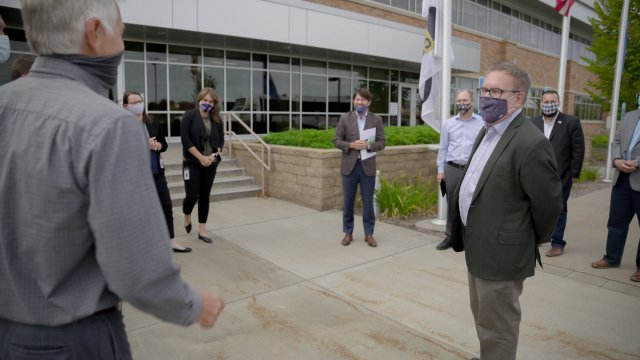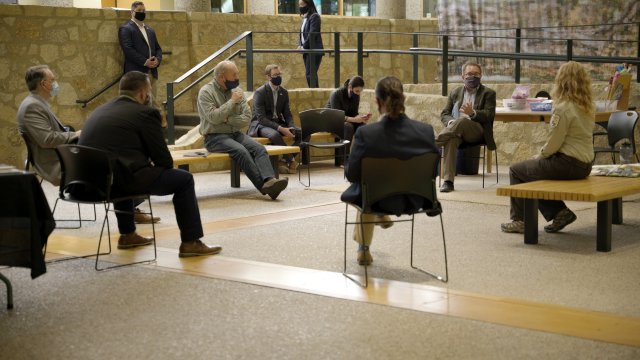Administrator Wheeler Wraps Up Minnesota Visit
Minneapolis, Minn. (September 29, 2020) — Today, U.S. Environmental Protection Agency (EPA) Administrator Andrew Wheeler wrapped up his visit to Minnesota announcing more than $73 million expected to be awarded for clean diesel projects, touring facilities at the Flint Hills Resources Pine Blend Refinery, and showcasing federal partnerships at the Minnesota Valley National Wildlife Refuge.
“Minnesota has been at the forefront of environmental innovation for decades, and these diesel grants will reduce emissions at construction sites around the state for years to come,” said EPA Administrator Andrew Wheeler. “These grants will help continue the dramatic trend in air quality improvements that America – and Minnesota – has seen since the Trump administration first entered office.”
“Technology and modernization play an important role in reducing and preventing pollution, and the work we are seeing here in Minnesota to transform these engines to reduce air emissions is a perfect example of this,” said EPA Region 5 Administrator Kurt Thiede. “We’re proud of the work being done here to improve air quality and revitalize the communities across the state – a priority under this administration – and we look forward to continuing this work together with our partners here and provide them with the resources needed to move Minnesota forward.”
“I am grateful to the EPA and Administrator Andrew Wheeler for this investment in Minnesota and for their commitment to the health of our communities. This funding to reduce diesel emissions will have lasting benefits to our state, Washington County, and our residents," said U.S. Congressman Tom Emmer (MN-6). "I applaud this Administration’s dedicated work to provide Minnesotans the means to reduce fuel emissions and improve our environment.”
At a press conference, EPA Administrator Wheeler announced over $73 million expected to be awarded in grants and funding to support numerous clean diesel programs and projects across the country at the state and local level.
Administrator Wheeler specifically highlighted the Minnesota Pollution Control Agency Diesel Emission Reduction Act (DERA) State Award, which will provide $515,073 for projects including engine retrofits, upgrades and remanufactures, cleaner fuels and additives, idle reduction technologies, engine replacements, vehicle replacements or clean alternative fuel conversions. These projects will reduce emissions of diesel particulate matter and other pollutants such as nitrogen oxides, carbon monoxide and hydrocarbons.
He also announced a State Award of $314,365 in DERA funding to the Leonardo Academy to replace four non-Tiered diesel engine construction cranes – owned and operated by Kramer North America – with four Tier 4 diesel engine cranes. Three of the cranes will be used in Hennepin and Washington Counties in Minnesota. Not only will the cranes reduce emissions along the project areas, but the projects, once completed, will reduce emissions due to less traffic idling time.
Under President Trump, the combined emission of criteria pollutants and their precursors dropped 7%. In the past three years, we saw the following drops in emissions of criteria and precursor pollutants:
- Nitrogen Oxides (NOx) ↓ 10 %
- Particulate Matter 2.5 (PM 2.5) ↓ 1 %
- Sulfur Dioxide (SO2) ↓ 16%
- Carbon monoxide (CO) ↓ 6%
- Volatile Organic Compounds (VOC) ↓ 3%
Over the last three years during the Trump Administration, EPA will have awarded about $300 million in grants and rebates to modernize the diesel fleet and speed the turnover to cleaner on- and off-road heavy-duty trucks and equipment. Much of this assistance has been provided to help better protect areas of poor air quality and areas of highly concentrated diesel pollution, such as ports and distribution centers.
Following the press conference, Administrator Wheeler and Regional Administrator Thiede toured facilities at the Flint Hills Resources Pine Bend Refinery in Rosemount, Minn. The day wrapped with a tour of the Minnesota Valley National Wildlife Refuge where they showcased partnership between EPA and U.S. Fish and Wildlife Services. The refuge connects the vibrant cultures of the Twin Cities metro area with the diversity of wildlife and habitat along the Minnesota River.
###



